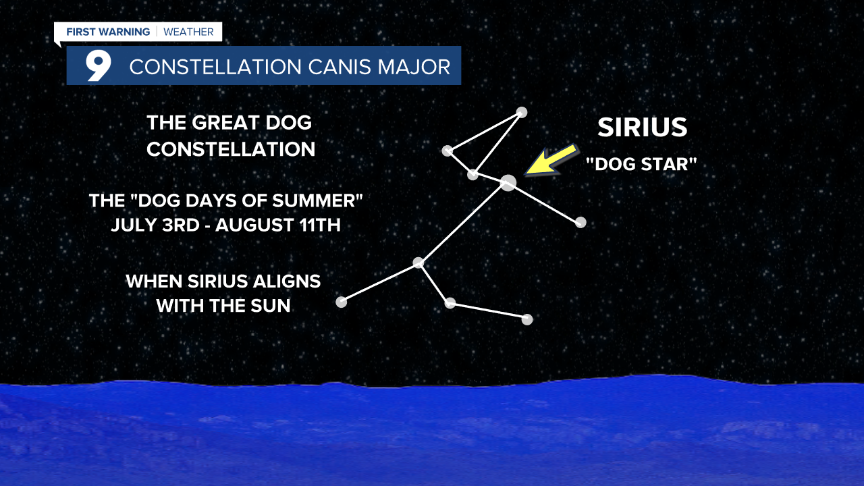TUCOSN, Ariz. (KGUN) — The “dog days of summer” are officially over and we have reached the peak of the Perseid meteor shower! First, let’s talk about “the dog days of summer” because many folks are familiar with the phrase but are unfamiliar with the origin of the phrase.
According to the Farmer’s Almanac, the phrase has nothing to do with actual dogs. The phrase actually dates back to ancient times when it was thought the Dog Star, Sirius, was contributing to the excessive heat of summer.
Sirius is the brightest star in the night sky and is part of the constellation Canis Major which is the dog constellation. Hence, the name Dog Star. From July 3rd to August 11th, the Dog Star aligns with the Sun and even rises and sets at the same time as the sun.
Ancient Greeks and Romans thought having the Sun and Sirius so close together was the reason it felt so much hotter from July into August. Of course, scientists later determined that the conjunction of the Sun and Sirius had nothing to do with the hotter temperatures typically experienced in July and August. Instead, the increase in heat had everything to do with Earth’s tilt toward the Sun during the summer which allowed for much more heating of Earth’s Northern Hemisphere surface during the summer months.

As the “dog days of summer” come to an end, one of the best meteor showers of the year reaches its peak. The Perseid meteor shower is one of the most anticipated meteor showers of the year because of the number of meteors we can see flying across the night sky during its peak.
As long as we get some breaks in the clouds, we have an advantage in spotting more meteors with this year’s display. The reason is because the moon is in its new phase. This will result in less moonlight which will give us a darker sky in which to see more meteors.
You may recall, meteors associated with the Perseid meteor shower are produced by debris from Comet Swift-Tuttle. According to Earth and Sky, Comet Swift-Tuttle was discovered in 1862 and passes through the inner Solar System once every 133 years. Each August, Earth passes through the trail of debris created by Swift-Tuttle and we are treated to a great meteor shower!
The nice part about the Perseid meteor shower is that we can just look up and likely see a few meteors. No special equipment is needed. However, if possible, it’s best to get away from city lights and your best chance of seeing meteors is between midnight and dawn. The reward for staying up late or getting up early should be well worth the effort!
By the way, the meteors we are able to see burn up about 60 miles above the Earth’s surface. If a meteor survives the trip through the Earth’s atmosphere and strikes the surface, the remaining portion becomes a meteorite. This is highly unlikely, but it does happen from time to time.

Let’s hope for some clear sky this week in order to catch a glimpse of some gorgeous meteors. If we don’t get to see any meteors this week, we’ll still be able to see a few through about the 24th of August. We can also view meteors knowing that the “dog days of summer” are over and
cooler days are just around the corner. At least, that is, if you believe ancient history. Happy meteor hunting!



